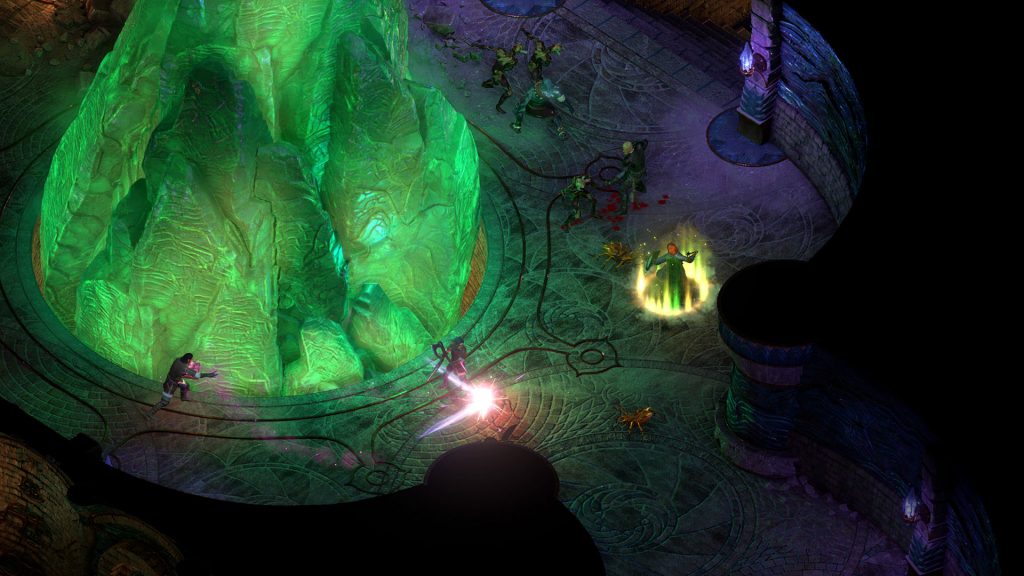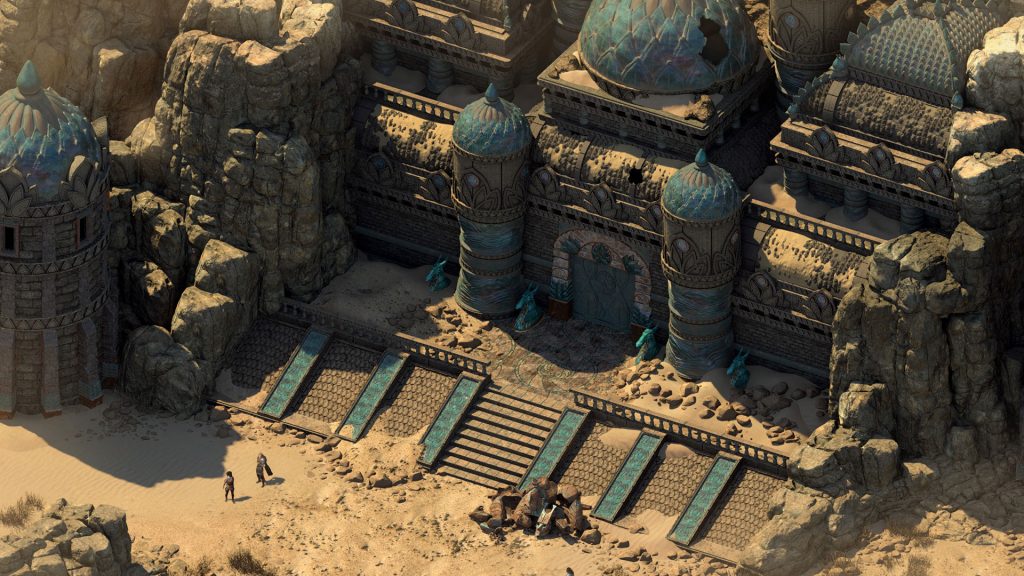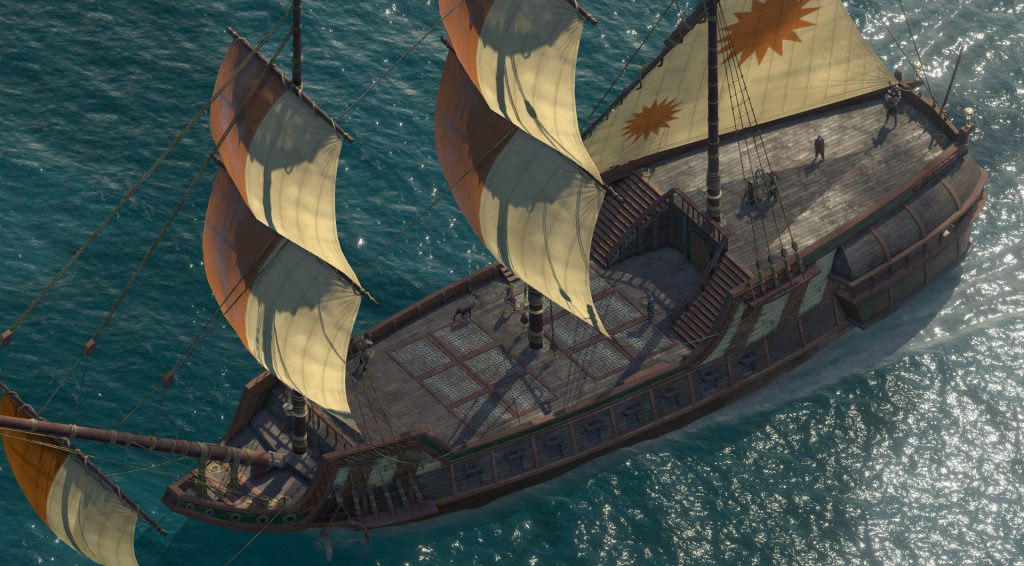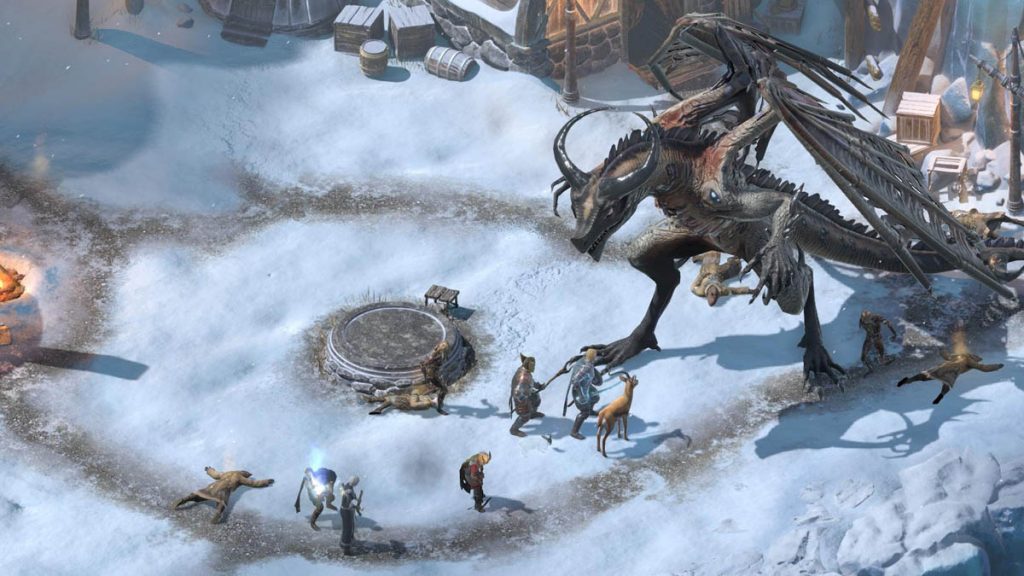
When Pillars of Eternity released in 2015 after a successful kickstarter campaign, it was with the promise of bringing back the CRPG genre. The goal was to be a kind of spiritual successor to Baldur’s Gate, and all in all it delivered on that front. It brought with it a diverse cast of interesting characters and a world you could get invested in.
Three years later the sequel released, and it took some pretty big risks. First of all it foregoes the traditional fantasy setting for a pirate themed semi open-world. Second it is much more focused on factions and faction quests. Think Fallout: New Vegas, not Divinity: Original Sin.
You are The Watcher
I played Deadfire in 2021, six years after I played the first game. I remembered little about the events in the first, which made the option of importing my choices from the first game kind of redundant since there is no recap. The game starts off in the inbetween. You meet the Pallid Knight, a god who tasks you with finding out why another god named Eothas is rampaging across the land. Your main character is a blank slate for you to fill in. You choose a class, a subclass, and then the Pallid Knight thrusts you back into your body. You wake up on a ship, with a familiar face from the first game, Eder, watching over you. But the ship hits a reef and you are forced to seek help on an island. This serves as a nice introduction to the mechanics of the game. You are a Watcher, a person who can commune with souls of the deceased. This opens up new paths of information gathering for you. It allows you to talk to a dead murder victim and choose to guide him to the wheel or, if you like, something more sinister.
Soon after washing up on the beach, you reach the first settlement in the game: Port Maje. It is a rather small settlement, headed by in parts the Valian Trading Company and the Huana, two of the factions in the game. After some introductory questing and exposition, you repair your ship and can set off into the world.
Building a world worth exploring
I love pirates, I really do. So for me The Deadfire is the perfect setting. The mix of trade companies, magic, pistols and ships make for a pretty unique setting all in all. And even though the open world is really just a map that you can move around on it feels big. There are lots of islands to explore. Most of them you kind of stumble upon, others get marked by quest givers. There is a great sense of exploration in this game, made even more so by the passage of days as you sail around, of having to hoard food and water unless you want your crew to mutiny on you.
This is where the game really shines. Finding an unnamed island and docking there never got old for me. There is always a ruin to explore, a quest to find. Descending into an ancient crypt and finding it a breeding ground for Fampyrs, or finding an exploration party much like your own who got locked in and succumbed to cannibalism and madness. There’s a bleakness in the Deadfire that carries over from the first game. This might be a colorful world but it is not a happy one. Death is everywhere: On a derelict ship fallen prey to the plague. In every settlement you come across. Your own party members can die permanently if they get more than four injuries. This is easily avoided if you’re careful, but it adds a sense of danger that is more sinister than the game over screen.
Apart from the abandoned wilderness there are several cities and smaller settlements where you can gather information and talk to people. The biggest one is Neketaka, which is essentially the capital of The Deadfire. Headed by Queen Onezaka II, the city is a breeding ground for corruption and power struggles between three of the game’s four factions. Religion, capitalism and tribalism clash in a fireworks off deceit and possible allegiances.
What unites all these areas is a tremendously beautiful visual design. Playing in 4k I stopped many times to take in the vistas. There is something about high fidelity-graphics in an isometric setting that just looks so, so good. Lush jungles, frozen wastelands and sprawling cities feel like real places due to all the things happening around you. If you have a good enough graphics card I really recommend cranking up the resolution.

The pitfall of scale
While the world is a beautifully imagined one, the factions are where the game falls short. There are four of them: The East India Trading Company-inspired Valian Trading Company, the indigenous Huana, the more militarised Royal Deadfire Company, and the pirates of the Principi. Sounds interesting, right? Well, be prepared to swallow a massive mouthful of exposition in getting to know them. Everywhere you go you are greeted with huge walls of text that, while beautifully written, tend to lean on the showing rather than telling-side of it. The factions will do their best to convince you their cause is the one worth pursuing, telling you of their values, what they strive for and what they want to oppose. It feels more like reading through a pamphlet than partaking in conversation.
There just aren’t enough interesting characters to make the exposition worth it. I never cared for anyone in these factions, they were all so bland and what you would expect from their faction. I guess the Principi is the most interesting one in this regard, but even there no one ever surprised me. Pirates do pirate things, the Huana are both angry at the foreign powers that claims their land and hopeful for a better future, as most civilisations who find themselves hosting foreign powers are. The two trading companies are so boring that I never really saw a big difference between them.
All this comes down to a matter of scale. When the game is mostly about faction warring and politics, the characters get lost on the way. When the main story is about gods and what they want with mankind, the scales are too high to create personal stories. It seems like the writers forgot about this. When one of my party members suddenly blurts out that they want to be in a relationship with me and I hardly feel like we’ve talked or even flirted, something is wrong with the characterisation. When most quests I do are inhabited by cardboard cutout number 57 of a poor lower-class Huana or greedy opportunist trader, the wall of exposition becomes ever more apparent.
It says something that the gods are the most interesting characters in the game. I felt like they actually have a personality, contrary to most other characters. But the interactions with them are so skewed power-wise that it doesn’t feel like it matters what you say or do anyway. And if the factions are supposed to be the main point of interest when it comes to plot there is much to gain by putting the organisational and political side on the backburner to focus more on the characters inside those factions.

Mechanics
This is an isometric, old-school game. You click where you want your characters to go, and they go there. Combat is a mix of real-time and pausing to hand out orders, much like Baldur’s Gate and Icewind Dale. The developers later added an option for turn-based combat which I haven’t tried, but I hear it works ok.
Since this is an RPG your party will gradually increase in power. You can choose to enable level scaling, but if you don’t the game will tell you if an area is a higher level than you so as to avoid walking into an unwinnable scenario. I played on the Classic difficulty level and found most of the main game to be a breeze. I never had to get into the nitty gritty of status effects and spell combinations until I got to the DLC (more on that later).
You find party members as you go along. These are the most fleshed out characters you can have in your party, with special side quests and elaborate backstories. After that comes the sidekicks, which are characters with names and a personality but that don’t really have a relationship to your main character in the same way. Lastly you can recruit adventurers at an inn if you want a class combination that isn’t available from the other options. These are basically stat-sticks without much of a personality at all.
Speaking of classes there are many in this game. Aside from the usual fighters, paladins, rogues and wizards, there are also ciphers, barbarians, monks, druids and a few others. A character can have one class or two. Going multi-class feels very complicated if it is your first time through, since you have to balance your skill points between two skill trees. Most classes also has sub-classes that add some flavor to the choice you’ve made. Seraphen for example is a Cipher with a special sub-class that makes his spells occasionally do additional positive or negative things in combat. All in all I feel like the class system is a good one that gives you a good deal of creativity in how you want to build your characters. That said it can be overwhelming if you’re new to these types of games. There are many damage types, buffs and debuffs to keep track of, and it isn’t always obvious which ones are good until you’re already deep into the game and might not have specced into them. Good thing there is a respec option available.
That’s it for the good stuff. The bad is mostly about the ship combat. While traveling around on your ship you can end up in combat with other vessels. When this happens you’re thrust into a text-based, turn-based window where you can circle around each other, fire cannons, increase or decrease speed, etcetera. This system is very poorly explained, I didn’t understand what many options did until I read up on it more than once online, and even then it felt unintuitive. I mostly ended up ramming the opposing ship and taking some hull damage to avoid the very drawn out, often losing battles since it was just more time-effective.
A disappointing main quest
The main quest, while interesting, is pretty short and doesn’t really involve your characters in any meaningful manner. Without saying too much the god Eothas has taken the form of a giant adra colossus and is rampaging across the land, and it is your job to find out what he’s up to. The scale of this quest is huge, eventually having you deal with things that could change the world forever. The writing focuses on interactions between the gods or organisations, forgoing the common man. You can enlist the help of a faction of your choice for the final quest, yet it doesn’t feel important since you never really developed a relationship with any of them throughout the game. I didn’t care about them enough to want to help them.
Regardless of how you choose to handle it the main quest has you visit four or five locations before it is over. I suspect that the developers wanted you to get sidetracked with the faction stuff to flesh out the playing time, in a way making the factions part of the main quest, and while I did just that it mainly had the effect of making me disconnect from the task at hand. When I finally got back to doing the last part of the main quest I’d done so much other stuff that it was like going back to a book I started reading six months ago.
Once again: there is a danger with setting the scales too high. It makes the small things feel less important, especially if the character writing isn’t especially strong to begin with. If you do have high stakes there needs to be a balance of power between your protagonist and your antagonist. When the antagonist is a god and the main interactions you have besides him are also gods, it doesn’t feel like you as a player matter.
DLC
There are three main iterations of DLC for this game, and they kind of overshadow the main game with their more focused approach.
The first takes place on a frozen island where people have gathered to worship an undead dragon. You set off to find out what is going on and find the god Rymrgand has a finger in it, asking you to step into his realm to help him fend off the dragon. I liked this DLC, it has some interesting story beats and poses a good challenge compared to the main game. It also ties in nicely to the history of the first game, having you relive events that happened in the past. I imagine many players will hit a wall when it comes to the final boss battle, at least I did. This is the first time you actually have to keep track of debuffs and interrupt casts if you want to do any damage and avoid being obliterated.
The second DLC is arena-based and takes place on a tropical island under the protection of another god: Galawain, although the inhabitans of the island has a different name for him. The main quest here has you uncover what is going on with the three godly masters of the arena who inhabit a talking statue. If you like the combat aspect of the game this DLC was made for you. It has several very difficult battles to attempt, with good rewards should you complete them. If you’re like me and mostly care about finishing the storyline you will get frustrated and abandon some of the tougher challenges. All in all I thought this was the weakest DLC story-wise. It has some interesting themes but it is clear the main effort has gone into crafting a good arena experience.
The third DLC is where it’s at for me. You venture into the Forgotten Sanctum, a place resting atop the sleeping body of the god Wael. Here you find two archmages who task you with venturing into different wings of the sanctum and uncovering what is going on. The visual design of this place is sublime, and it twists the traditional dungeon-crawling experience in an interesting way. There are areas where you are free to walk around and interact with the librarians of the place, and there are infested areas where some very tough battles await. Speaking of tough battles, the final boss in this DLC will kick your ass if you’re not prepared for it. I had to resort to reading up on spell combinations and crafting special potions to even stand a chance, and I think the jump in difficutly would have been less jarring had the game had a more incremental approach. As it stands I breezed through most of the game up until this point and was completely taken aback by how hard it was to beat.

Parting words
I had a good time with Pillars of Eternity 2: Deadfire. It’s a long, fun game even if most of it is made up of sidequests. The worldbuilding and visual design is top-notch through and through. The game could have been a classic had it not been for the less than stellar writing, with too much exposition and too little character and personality. If you decide to try it out I recommend buying at least the Beast of Winter and Forgotten Sanctum DLC since they are by far the best parts of the game.
Pillars of Eternity 2: Deadfire is a creative approach the CRPG genre. While the character writing leaves something to be desired, the general gameplay and combat system is deep and satisfying. If you are a fan of Baldur’s gate and pirates you should give it a try.